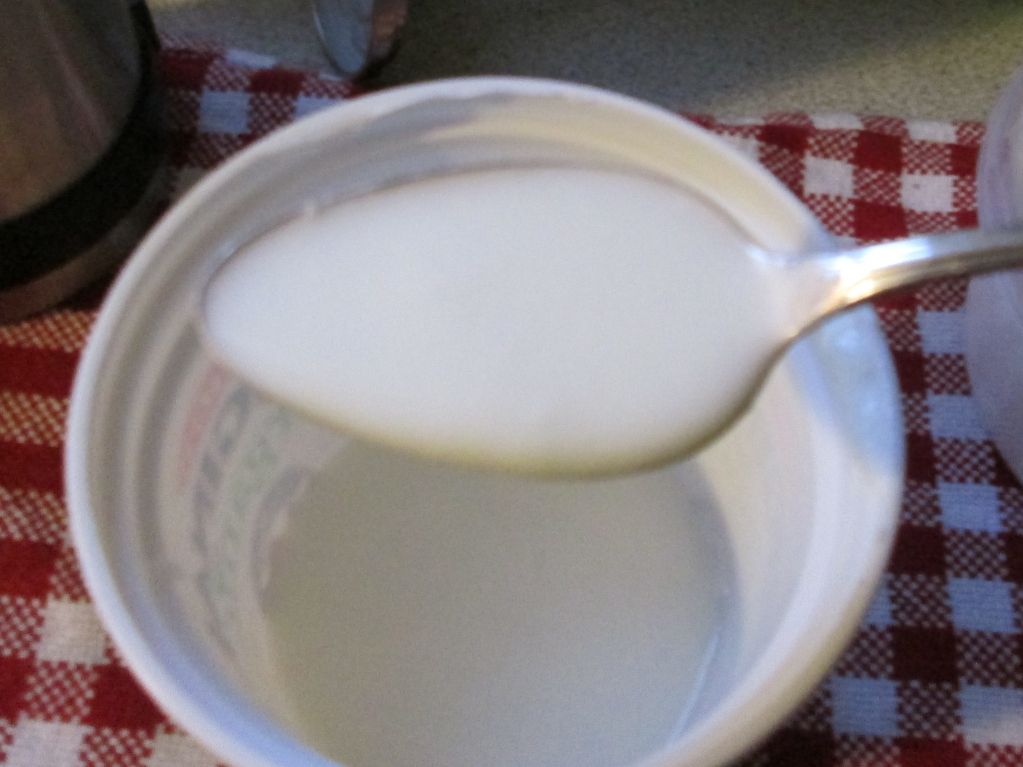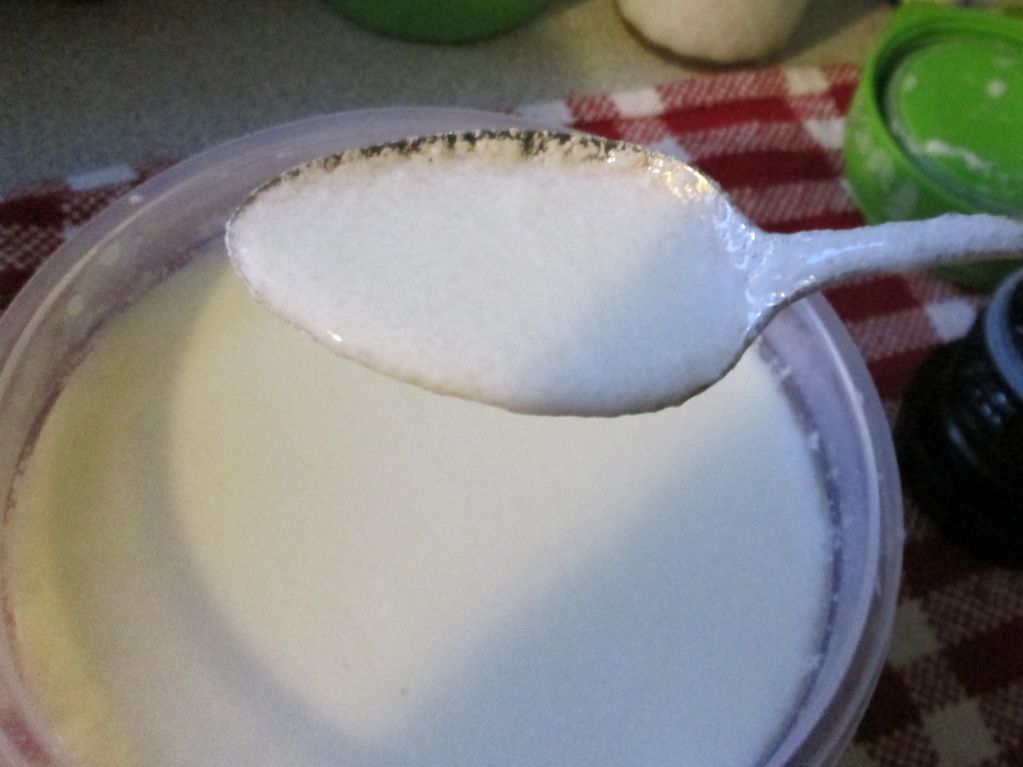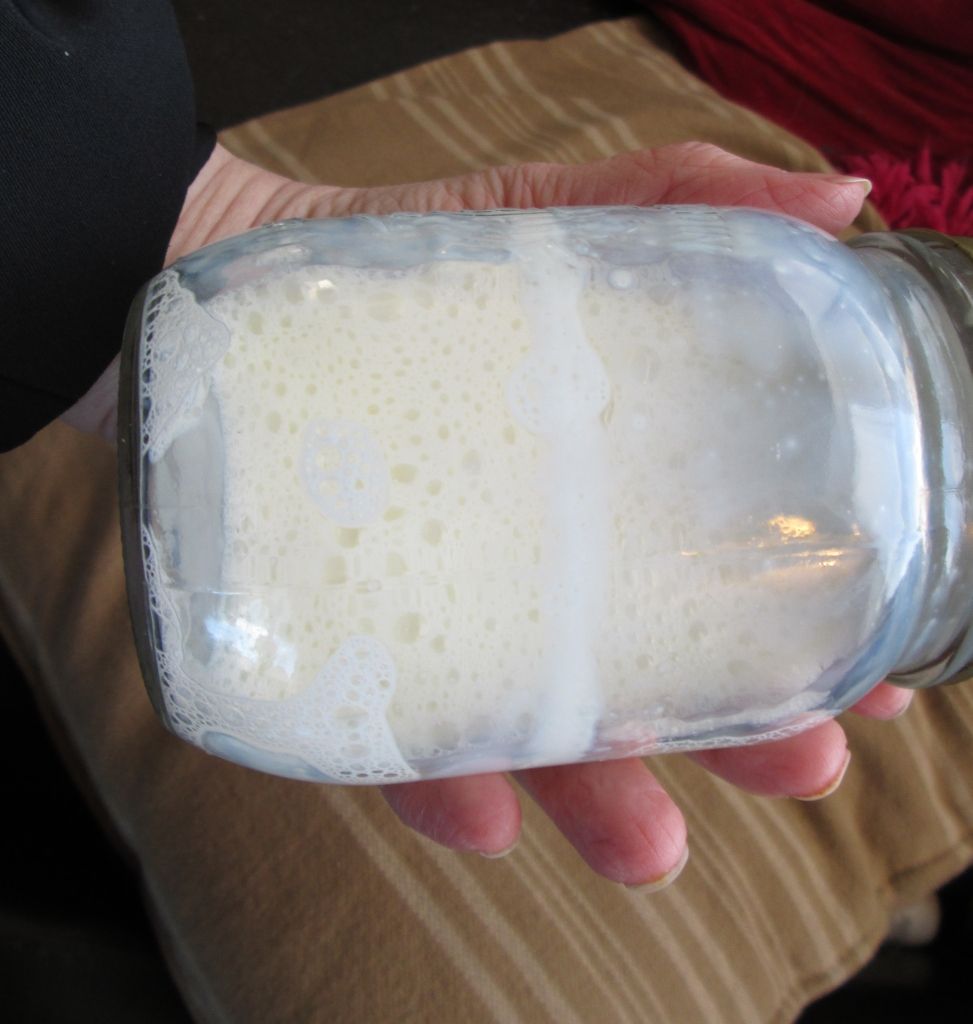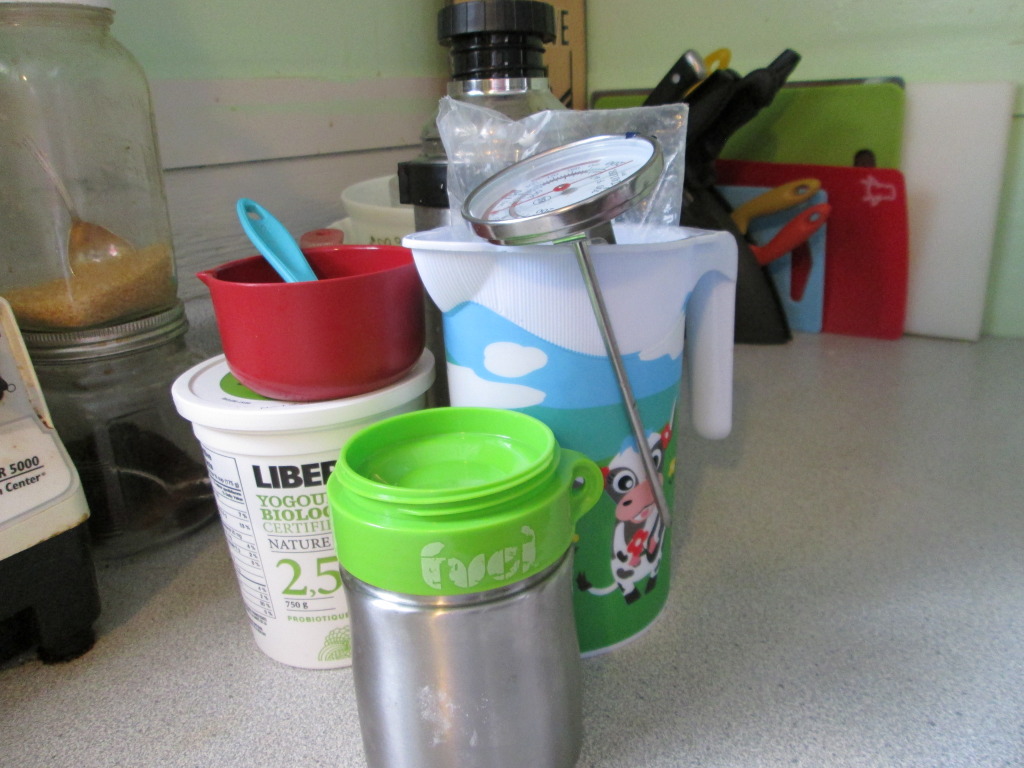If you're new here, you may want to subscribe to my RSS feed. Thanks for visiting!
I was absolutely determined to make yogurt. Real, yummy delicious yogurt, the nice thick kind that can stand on its own in a dish, supporting a big spoon full of fruit.
Yogurt has so many good things going for it! I eat it almost daily and contribute my resistance to stomach viruses and my greatly improved acid-reflux to the habit. You can read more about the benefits and some tasty ways to use it in my “Ode to Yogurt”.
Attempts #1 and #2
Attempts 1 and 2 were made simultaneously. The only difference between the two was that #1 was made from pasteurized milk from the dairy and #2 was made from reconstituted powdered milk.

I used the “thermos” method, found in detail HERE.
Basically, the thermos method is as follows.
- Heat 1 cup of milk to 165-185 degrees F (use a candy thermometer – or, wait until you are starting to see some bubbles rising but the milk is not yet boiling).
- Remove the milk from the heat and allow it to drop to 105-110 degrees F.
- Gently stir in the starter (1 tablespoon of yogurt with live cultures). You want it to be well-combined but don’t use anything crazy like an immersion blender. Just a whisk will do.
- Immediately place the mixture into a thermos that has been warmed with hot water and put the lid on.
- Keep the thermos cozily wrapped in towels overnight (8-24 hours).
You should get up to delicious, rich, thick yogurt.
I, however, did NOT get up to delicious, rich, thick yogurt. I got up to runny, drink-it-through-a-straw yogurt. I was seriously bummed.


I noticed, however, that the powdered milk yogurt was thicker than the refrigerated milk yogurt. That got my wheels turning a little.
Attempts #3 and #4
In the face of my early morning disappointment, I decided to try a few different things with the next batches.
I searched up “Why is my thermos yogurt runny?” and found this awesome site, Not Quite Nigella, had some interesting suggestions.
My next two batches were made from a cup and a half of milk from the fridge with 1/3 of powdered milk stirred into it. I was hoping that if the milk was thicker to start with, so too would be my yogurt.
I made another attempt at the thermos method, described above, with half of the mixture.
With the other half, I tried the blog’s “oven method.”
While my milk mixture was heating on the stovetop, I turned the oven on to 300 degrees F.
I washed a pint Mason jar and filled it with scalding hot water to keep it warm.
When the milk had been innoculated with the culture, I poured the half that didn’t go into the thermos into the empty, warm jar and placed it on a pan, popped it in the oven, and turned off the heat. I left it in the warm oven for 5 hours.
Alas, it resulted in runny yogurt.

I had, at this point, reached my yogurt frustration threshold. I spoke rather impolitely to the yogurt in the thermos, wrapped snugly in its towel. I left the thermos on the stove while I baked a batch of cookies. I turned on the oven a couple of times to keep things warm in the kitchen. I strongly suspect my other failures are because my house is so chilly, a fact that is really only bothersome when making yogurt or waiting for bread to rise..
I left the thermos of yogurt for 11 hours. I opened it…and ……SUCCESS!!!!! Happy dance in the kitchen!!!!

So, the keys to the successful batch of yogurt were…
- The thermos method
- Adding 1/3 cup of powdered milk to each 1-1/2 cup of regular milk
- Warming up the kitchen a few times throughout the day.
















17 Responses
I used to make yoghurt a couple of times a week, but since we moved to a South East Asian country and dairy products are so expensive I have stopped. However, you can guarantee when we move back home, I’ll start up again.
I only ever used whole milk. I got thick yoghurt without adding powdered milk. I did find that the original starter made a difference. If I used super thick commercial Greek yoghurt for my starter, the result was a thicker yoghurt. Once I was using my own starter (left over from the last batch), I got consistently beautiful yoghurt.
I used a commercial ‘cooker’ to culture the yoghurt called an EasiYo maker. In New Zealand you can buy powdered yoghurt sachets that you just add water to and then place inside the EasiYo maker. Boiling water is poured around the sides, the lid is added and then there is yoghurt the next morning. I forgoed the powdered mix and made my own milk + starter but still used the commercial maker to keep the yoghurt warm (no power needed).
I definitely agree that heat is your problem. I suspect if you can get the temperature right you won’t need to add the powdered milk. I don’t know whether it is worth looking into finding an EasiYo maker given NZ is a long way from where you are but it does make it super easy to make the best yoghurt in the world. Nothing commercial can top my yoghurt – I’ve always thought that if I was on death row, my last meal would be my yoghurt!
Thank you for the suggestions, Rebecca!
I have to agree, the flavor of the stuff I’ve made (even without the desired thickness thus far) is far and away better than the grocery store stuff!
I don’t know if you have access, but one of the articles I linked to said that you can make yogurt from alternate types of milk, like soy milk, etc. Might be worth looking into with dairy being outrageously priced. 🙂
Daisy
there is a yogurt starter called villi. it doesn’t require heat to produce excellent yogurt. 2% non pasteurized milk with the starter and leave on counter for 4-12h depending on the room temp. It is a moderate textured, creamy ‘greek’ tasting yogurt. If strained overnight in fridge in a double cheese cloth, it can make a thick greek yogurt or if left longer it makes a formed soft cheese common to the middle east.
BTW, I misspelled the name. It is viili. I got my viili starter at culturesforhealth.com and kept it going all summer last year. I cultured 4 cups at at time in a mason jar, and when it would thicken, I transferred 1 heaping tbl to another mason jar with 4 more cups of organic milk and always had 4 or more cups of yogurt to eat in 2-3 days. It is super easy and convenient, however, I am unsure how it would do with goats milk, powdered milk or other milks such as coconut. Good luck!
Oh thank you!!!! I will see if I can find that. I’m in the boonies so I will likely have to order it! 🙂
I suspect the 350 oven may have killed the culture, even though you turned it off when you put the yogurt in.
Easy Yogurt…Every Time
Turn oven light on…do not turn the oven on. I use a half gallon of milk (any) and 4-6oz greek yogurt. Put the milk in a large pot, over med heat, bring temp to 180F. Remove from heat, let stand until temp drops to 110F.
Skim off that milk skin on top of milk. Add the yogurt… swirling, not mixing. You want little clumps throughout the mixture. At this point if you want to add honey and vanilla, you can or just keep as plain (kids like it sweeter). I think I used 1/3c honey and tsp vanilla.
Then put the mixture in pint or quart mason jars making sure to get some little yogurt clumps in each jar. Add lids and rings. Rinse out your big pan you just cooked the milk in, put a towel in it, draped over sides. Put jars in it, wrapping the towels around and over top. If your home is cold…wrap more towels for insulating. Put this into the oven with the oven light on and leave it there for a min of 12 hrs.
It takes an hr of preparing so if you want cold yogurt in the morning, you should make it in the morning so by nighttime it is ready and you can refrigerate. When I use my yogurt as the starter, rather than store bought cup, it is more “loose” but still good.
You shall be very happy 🙂
Thank you! I’ll try this! 🙂
Honey is antibacterial so I’d think it would kill the cultures, at least that’s what it does with water kefir grains.
So if milk with honey doesn’t result in the desired yoghurt, add the honey AFTER the yoghurt is done.
And yes, make sure the milk is not too hot when you add the cultures. Even the oven light might be too hot (mine definitely is), depending what kind it is and how close you place the milk to the light. Better have it as far away from the light as possible and maybe even open the oven door a little.
I once lived in a hut without electricity in the winter for a couple of months where I put raw goats milk in a jar and took it with me to bed at nights. After 2 or 3 nights I had yummy yoghurt.
If you start with a Greek yogurt, your resulting yogurt with come out thicker. Once the yogurt is done, strain in a cheesecloth which gets rid of the extra liquid (can be used for soups). Then you’ll have thick Greek style yogurt.
Another technique, once you’ve made the yogurt, is to strain it using cheese cloth (I triple fold at least). Sometimes the store I go to only has 2% greek yogurt instead of full fat, and it is too runny for me, so by straining it, what remains in your cloth is thicker.
CROCK POT YOGURT onegoodthingbyjillee.com
Love this site!
Thank you for linking to my yogurt-in-thermos-recipe. I’m so glad you tried it, and sorry it did not turn out for you. Years ago, I made yogurt with powdered milk added to help make it thicker, but I did not care for the chalky taste, so like you, I kept experimenting until I found a method that gave me the results I wanted.
I have found that different starters net different results. Most commercial yogurts are as thick as they are because of added gelatin. Natural yogurt usually isn’t that thick, so our palates have been trained to expect something we may not get making pure, homemade yogurt.
Another thing I found over the years is that using a tablespoon or so inoculant from a store-bought yogurt gives me inconsistent results, as not all have enough live culture (or any) to innoculate the milk properly. The Yogourmet starter I mention in my article works very well for a thicker yogurt, however.
Once you have made a yogurt that gives you the consistency and taste you want, the key is to keep out a bit for the mother and use it to make a new batch within 3-4 days. As long as there are plenty of live cultures in your mother, and you cool the milk to a temperature that is ideal for growing the culture, then keep it there for 8-12 hours, you should get a consistent result every time.
Again, thank you for providing a link to my yogurt recipe. I’m glad you continued to experiment until you found a recipe that works for you. Homemade tastes so much better than store bought!
I don’t know why greek yogurt is so popular. Bulgaria invented the yogurt and I like Bulgarian yogurt way better than the greek one.I make my own yogurt with this onehttp://www.trimonayogurt.com/(the only Bulgarian I was able to find-may be that’s why not too many people know about it,because it’s hard to find it,but it is sooooo yummy.You can try to find it in any small fresh farm market.
I don’t use anything besides organic whole milk(cool off till you can keep you finger in it without feeling it hot-sorry for the explanation:)) than poor it into jars and add 2-3 tbsp.of yogurt to each one.Cover it with few towels to keep it warm and it should be done in 5-6 or may be 7 hours.Don’t keep it too long,because it will get sourish.
Good luck and thank you for the great recipes:)
A company from New Zealand named Easi-Yo has made a container that you can make yogurt in. It has an outer part and an inner part. You put boiling water in part of it and the yogurt is in it’s separate part and you let it sit for up to 12 hours and your yogurt is made. They also sell yogurt mixes if you have trouble with it from scratch.
I get raw milk from a local Amish family and take off the cream for butter. To make my yogurt, which is very forgiving, I heat the milk (sometimes with a bit of dry milk mixed in) to around 160 degrees, then (because I’m impatient) I cool it to around 100-110 by setting the pot in a sink of ice water, stirring it so the temp is even. (If you are the patient sort, you can just let it cool on its own.) For each quart of milk, I stir in no more than a tablespoon of yogurt (from my previous batch, but my original starter was a spoon of plain Greek yogurt). Seems that I read somewhere that this is a case of “more is not better” because the yogurt critters don’t like being crowded, so adding more culture isn’t going to help in any way. I pour the mixture in warmed jars, put on lids, and put them in a smallish thermal bag (like an insulated lunch bag) and fill any extra spaces with jars of hot tap water to keep the temperature around 100 degrees or so. Somewhere around 6 hours later I have a nice, thick, plain yogurt. The longer it sets, the sharper the taste. (I’ve let it set for 12 hours and it was fine, and also stopped at 4 hours and had good yogurt.) If I want something more like cream cheese, I drain more whey out of it. Just save a little of the yogurt for starter for your next batch. Homemade yogurt is soooo much better than what you buy in the store!
WHAT IF…?! Would this work..IN A CROCK POT?! If I put the measurements you provided, and threw it in a crock pot, on low, overnight…? What do you think?
I put my thermos on top of my hot water heater if in a house with electricity. Agreed, never add sweeteners or flavorings before it’s yogurt. I’ve made it with just fat free powdered milk but I like to mix the milk double strength. I’ve made it with good greek yogurt and I’ve made it with cheap crappy single use store yogurt.